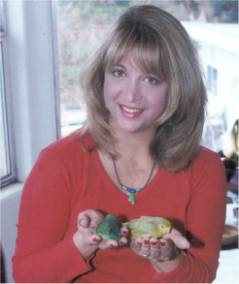Wednesday, January 8, 2014
Diminishing Parrotlet Lifespans
Greetings Sandee, I read on your blog that Parrotlets used to live to 20 or older but now usually only make it to 10. I was wondering why that might be, and two possible causes came to mind. First, maybe it's because all the birds have become more or less inbred since 1992. Second, maybe the grains their pellets are made from are having an effect. Soy and corn have become mostly all GMO in the last twenty years, and virtually all our wheat now comes from a hybrid that was developed in the 1970s. This wheat has been giving a lot of trouble to a high percentage of us humans who eat it (see "Wheat Belly Blog" online). So maybe, since birds are such fragile creatures, which have never eaten these grains in the wild, these "frankenfoods" are having a negative impact on them too. My 6-year-old PP "Cootie" loves quinoa, so I've been increasing the amount of that that I give him. Opinions? I really enjoy reading your blog!
Vickie
Dear Victoria:
Thank you for your message and your very kind words.
The problem with shortening lifespans in parrotlets in captivity has to do with several factors.
Yes, many of the birds are inbred and closely related. This happened before the Wild Bird Conservation Act but certainly that was part of the problem. I remember a friend, prior to the passage of the WBCA in 1992, bought 3 Green Wing macaws. One came from California, one from Florida and the other from Texas. DNA testing proved all three birds were related. So it isn't just because of the WBCA, it also had to do with a limited genetically diverse captive population prior to its passage.
The second biggest problem was human greed and ego. When the color mutation Pacifics started being imported back in the mid-1990's many people got rid of their other species and normal Pacifics in order to breed pretty new colored birds. Not only could they make 10 or more times the amount of money per bird as a normal Pacific or Green Rump or Spectacled, they also could make new colors by combining them, therefore 'creating' new mutations that gave them recognition and 'fame' for lack of a better word. By the time people realized that the mutations were so plentiful that their prices had fallen into the basement, it was too late to breed the other species as most were all but disappeared from American aviculture (especially the less common species of Mexicans and Blue Wings).
Mutations are genetically abnormal birds. In the wild, Nature usually 'weeded' out these birds. However, we humans like the abnormal colors so we bred more of them which, with mutation breeding, means lots of line-breeding (if you are doing it 'right') or more often than not 'inbreeding'. Line breeding means breeding cousin birds and inbreeding is breeding siblings and parents to offspring. Very few of these people outcrossed them to normal or wild-type parrotlets. Again, by the time people realized they were getting incorrectly sized birds, bad feather conditions and loss of fertility as well as birth defects, it was too late to find normal, wild-type Pacifics to breed out some of these genetic defects.
As for GMO's and that kind of thing, I have no idea. I'm not a scientist. However, I do know that unless you are feeding pelleted diets, most bird seeds to not contain a lot of GMO's. Most pelleted diets are manufactured from corn, something I have avoided for more than a decade to feed both myself and my birds due to its low nutritional value and high sugar content. Most bird seeds do not contain soy. But, even if it did, I would say it would be affecting ALL birds not just parrotlets so I doubt that has as much to do with it.
As for being 'fragile' nothing could be farther from the truth. Parrotlets are little tigers. They are aggressive, territorial and not only survive in very harsh environments where everything eats them, they are thriving and expanding their range in their countries of origin. Indeed, in a lot of places they are considered 'pests' in that they nest under the eaves of houses, in attics, barns and are often seen in cities hanging out much like pigeons in the US. Not to mention they also descend upon farms destroying all those crops of grains, wheat, sunflower, etc. So they do indeed consume grains in the wild.
Hope this helps!
Sincerely yours,
Sandee L. Molenda, C.A.S.
The Parrotlet Ranch, Owner, www.parrotletranch.com
A Chattering Bird Builds No Nest.
Camaroonian Phrase
Labels:
Color Mutations,
Diet,
GMO's,
Inbreeding,
Line-Breeding,
Parrotlets,
Pellets,
Pest Species,
WBCA
Subscribe to:
Post Comments (Atom)




No comments:
Post a Comment
Note: Only a member of this blog may post a comment.